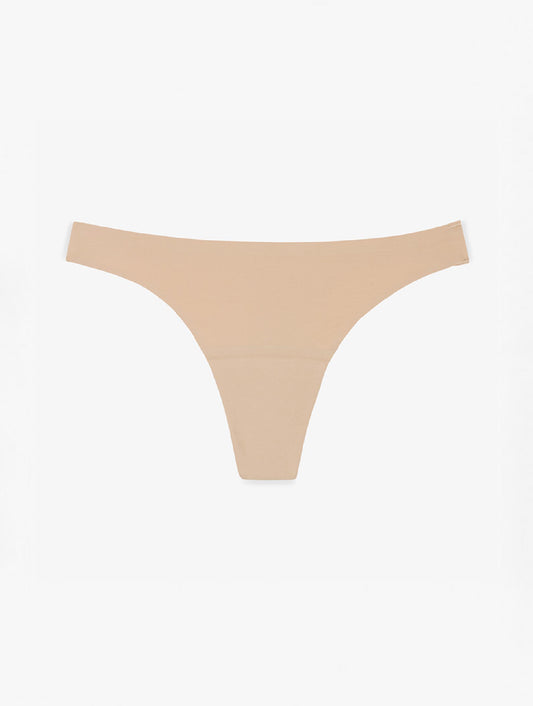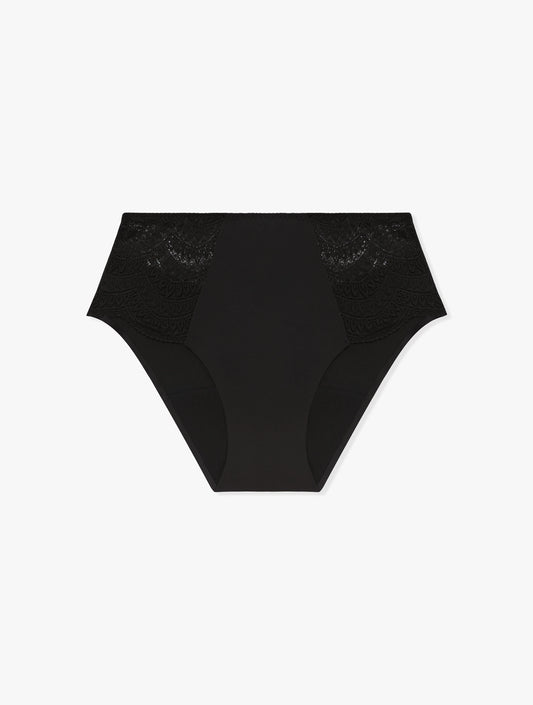Spotting: we tell you everything about this bleeding outside the period
Have you ever heard of spotting? No ? This is light bleeding, generally harmless, which occurs outside the period of menstruation. Does this mean anything to you? We explain to you why these small losses can happen.
Understanding the definition of spotting
We will never stop telling you: the female menstrual cycle is not always regulated like clockwork and differs from one woman to another. Same process for the symptoms that accompany the menstrual cycle: some women will suffer from stomach aches, be more greedy or more tired. And others will discover this famous spotting…
Behind this English term meaning spot , hide small bleedings which appear outside the menstrual period and which affect a large number of women. Spotting should not be confused with rules .
Faced with spotting: use menstrual panties
If you are dealing with spotting, menstrual panties can be an effective solution. Indeed, this underwear specially designed to absorb menstrual blood can also manage small blood losses due to spotting . It thus offers optimal comfort as well as discreet and safe protection during the day.
Thanks to their absorption capacity and comfort, panties and other menstrual shorties or menstrual thongs are a practical and ecological solution for managing spotting.
Spotting or rules? What a difference ?
First difference: unlike menstruation, during spotting, the blood does not flow continuously , but rather drop by drop. This comes from the uterine cavity.
Another difference: the spotting is less abundant and generally darker in color (sometimes tending to brown). Finally, spotting bleeding is punctual, unlike menstruation which is cyclical.
Have you ever had bleeding outside of your period? Don't panic, generally, these bleedings are not serious. However, if they persist, we advise you to make an appointment with a gynecologist.
The causes of spotting: stress, ovulation and others
Spotting has several possible causes, with stress and ovulation among the most common. Indeed, stress can lead to hormonal imbalances that can cause this bleeding. Ovulation, due to the hormonal peak it causes, can also be the cause of spotting.
Several other factors can also be the cause of this intermenstrual bleeding:
- Hormonal contraception , especially during the first three months of use, can cause spotting. This is particularly the case with the estrogen-progestin pill.
- Spotting can be a sign of implantation , that is to say the implantation of the embryo in the endometrium.
- More general hormonal imbalances , such as luteal insufficiency or low estrogen, can also cause spotting.
- Menopause and puberty , two periods of great hormonal upheaval, can be accompanied by spotting.
- Finally, certain illnesses, such as asymptomatic sexually transmitted infections , can cause breakthrough bleeding.
It is therefore essential to consult a healthcare professional if spotting persists or appears in an unusual way.


Aphrodite period thong







Selene microfiber menstrual panties
Spotting and pregnancy: implantation
Implantation, a crucial stage of pregnancy, can also lead to spotting. After fertilization, the fertilized egg migrates to the uterus and implants there, a process that can cause light bleeding, known as implantation spotting. This phenomenon, which generally occurs 6 to 12 days after fertilization , is often the first sign of pregnancy.
This bleeding is usually lighter and lighter in color than your usual period . They may be accompanied by mild abdominal pain, similar to menstrual cramps.
However, implantation spotting should not be confused with early miscarriage or ectopic pregnancy, which can also cause bleeding. It is therefore recommended to consult a healthcare professional if in doubt.
Color and duration of spotting: what to know?
The color of spotting usually varies between brown and pale pink , although this may depend on its cause. Fresh blood is often bright red, while older blood may be brown or even black, like black periods . These color variations are explained by the oxidation of the blood which has remained in the genital tract for several days.
The duration of the spotting is random , it varies from one case to another. In some cases it may last for a few hours, in others it may persist for one or two days. However, if spotting continues or is repeated over a long period of time, it is advisable to consult a healthcare professional.
Bleeding outside of periods: is it spotting?
When bleeding occurs outside of your period, it may be spotting. This phenomenon, often benign, is characterized by slight blood loss from the uterine cavity. Bleeding is generally less heavy than during menstruation and darker in color.
We also distinguish metrorrhagia, bleeding which, although weaker than periods , and which can last several days. The causes of this bleeding outside the period are numerous, ranging from hormonal imbalance, pregnancy, infection or trauma.
It is crucial not to confuse spotting with a real period as it has no relation to the normal menstrual cycle. Spotting can occur at any time, whether before, during or after your period.
Pill spotting: is it normal?
Spotting may occur in some women taking birth control pills, and this is usually normal. The hormones in the pill can disrupt the body's natural hormonal balance, which can lead to light bleeding outside of your period.
This is particularly common when initiating contraception or changing pills. However, if the spotting persists beyond the first months of using the pill, it is advisable to consult a health professional. Gynecologists can offer solutions to reduce this bleeding , such as adjusting the hormonal dosage of the pill, or even changing the means of contraception.
Spotting and copper IUD: a link?
The copper IUD is a hormonal-free contraceptive device, which can have effects on the menstrual cycle and in particular cause spotting. It is in fact common to observe bleeding outside of menstruation after insertion of such a device. This is generally not serious, but can also be a sign of inflammation of the lining of the uterus or expulsion of the IUD , hence the importance of consulting a health professional if in doubt.
In addition, switching from hormonal contraception to the copper IUD can cause spotting. It is therefore essential to be vigilant about the changes that could occur after insertion of a copper IUD.
Finally, some women noted that their periods were longer, heavier and more painful than before the copper IUD insertion, and suffered from spotting more regularly.
In conclusion, there is indeed a link between spotting and copper IUD , but it is not systematic and varies from one woman to another.
Spotting and lower abdomen pain: to watch out for
Spotting associated with lower abdominal pain can be a sign of different health problems. Among these problems, we find in particular digestive disorders, urinary or genital infections, or even gynecological problems such as uterine fibroids or uterine polyps.
Other causes may be linked to hormonal imbalance, as is often the case with spotting. In case of persistent pain and spotting, it is best to consult a healthcare professional.
It should also be noted that certain more serious conditions, such as endometriosis or pelvic congestion syndrome, can also be the cause of these symptoms . These illnesses require appropriate medical care.
Treatment for lower abdominal pain and spotting will depend on the cause identified. This may include drug treatment, lifestyle changes, or specific medical procedures.
Spotting during premenopause: what you need to know
Spotting can also be a warning sign of perimenopause, a transition period that precedes menopause. Premenopause , which can last 2 to 4 years, is characterized by irregular cycles and unpleasant symptoms. It can lead to intermenstrual bleeding, also called spotting.
This bleeding is usually not serious, but it can sometimes be a sign of a more serious health problem. It is therefore essential to monitor this bleeding and consult a healthcare professional if necessary.
During this transition period, significant hormonal variations occur, which can lead to disruptions in the menstrual cycle. Thus, spotting can be more frequent and sometimes more abundant during premenopause.
It should be noted that the initiation of hormonal replacement treatment (HRT) during menopause can help the disappearance of spotting.
How to stop pill spotting?
To stop pill spotting, several options can be considered. The first step is to consult a healthcare professional for an accurate examination and diagnosis. If the spotting is due to a hormonal imbalance caused by the pill , a dose adjustment or a change in contraception may be recommended.
In the event of an infection, such as chlamydia, antibiotic treatment will be prescribed. Natural solutions can also be considered , such as consuming certain plants in the form of herbal teas, known to reduce menstrual flow. Finally, certain habits can help, such as taking the pill at a set time each day.
Solutions and advice for managing spotting
To manage spotting, several solutions are possible.
-
Identify the cause : This is essential to provide a suitable solution. If spotting is related to jet lag, try to return to your usual routine as quickly as possible.
-
Choosing the right sanitary protection : For light flows, a tampon may not be the most suitable option. Period panties could be a comfortable and eco-friendly alternative.
-
Monitor your cycle : In the event of recurrent spotting, it may be useful to keep a diary of your cycle, to note the frequency and intensity of bleeding.
-
Adopt a healthy lifestyle : Habits such as a balanced diet, good hydration and regular physical activity can help regulate your menstrual cycle and reduce the frequency of spotting.
-
Consult a healthcare professional : In the event of persistent, unexplained spotting or accompanied by pain, do not hesitate to consult a healthcare professional. Medical treatments, such as adjustment of contraception or antibiotic treatment in case of infection, may be necessary.

























